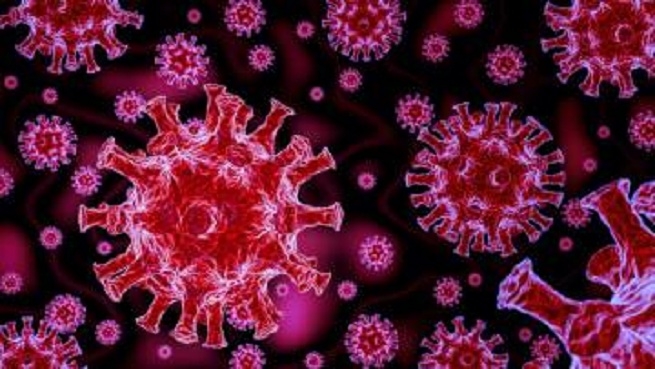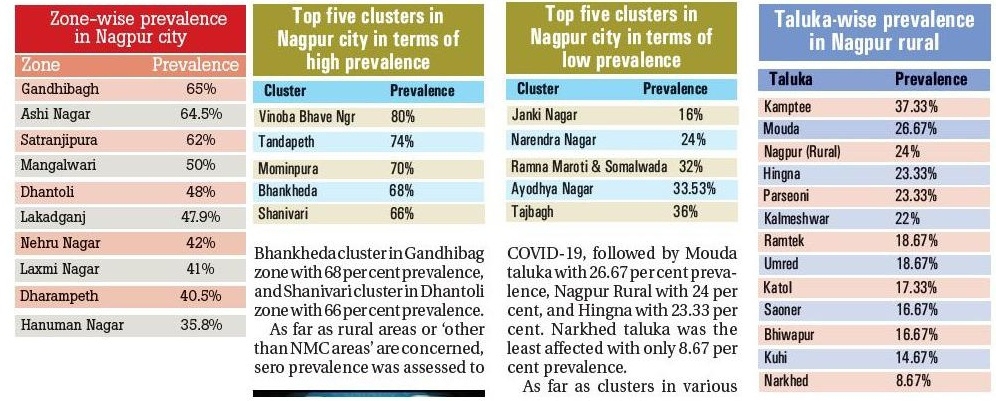64.83% population ‘still vulnerable’ to COVID-19 in distt: Sero survey
| Date :13-Nov-2020 |

By Kartik Lokhande :
Sero prevalence of COVID-19 was found to be 49.7% in Nagpur city, 20.7% in rural areas of district
THE administration, on Thursday, officially released the results of COVID-19 ‘Sero Survey’ conducted in Nagpur city and rural areas of district. As per the survey results, 49.7 per cent of population surveyed in Nagpur city had presence of antibodies, indicating past infection of COVID-19. In rural areas, the prevalence was 20.7 per cent. The prevalence in district as a whole -- including Nagpur city and rural areas -- was 35.17 per cent. Based on the results of sero survey, the administration has warned that 64.83 per cent population in Nagpur district is ‘still vulnerable’ to contracting COVID-19 infection. “All people residing in Nagpur district are advised to follow social distancing norms and avoid crowding, social gatherings of any sort, and wear mask and use sanitiser.

People are also advised to get themselves tested and isolated at the earliest, in case they develop symptoms like cough, fever, and breathlessness,” cautioned the administration in an official statement about sero survey released on Thursday. To assess ‘sero prevalence’ of COVID-19, the sero survey was carried out in the district from October 15 to November 5. During the survey, blood samples were collected from all over the district and those were tested for presence of antibodies against COVID-19. Antibodies are fighting mechanism developed by body. “They are indicative of past infection of coronavirus,” the administration stated. Sampling was done in a scientific manner as followed by Indian Council of Medical Research (ICMR) in other parts of country while conducting sero survey. All the individuals below the age of 18 years were excluded from this survey.
Though total sero prevalence of 49.7 per cent was assessed in Nagpur city or the area under the jurisdiction of Nagpur Municipal Corporation (NMC), the prevalence varied across zones and clusters. This survey was carried out in all 10 zones of NMC. Each zone of NMC was further divided into four clusters, which were selected in scientific manner and 50 samples were collected from each cluster, that is, around 200 samples from each zone. In all, 1,992 samples were collected from NMC area and tested. As the results of the survey show, Gandhibag and Ashi Nagar zones had 65 per cent and 64.5 per cent prevalence. They were followed closely by Satranjipura zone with 62 per cent prevalence. This means, this much of the population of these zones had contracted infection of COVID-19 sometime in the past. The lowest prevalence was 40.5 per cent, in Dharampeth zone.
According to experts, the areas where sero prevalence has been the lowest are the ones that may be vulnerable to the feared second wave of COVID-19 infections. However, even in areas where more than 50-60 per cent population was found to have antibodies for COVID-19, the remaining population is still vulnerable. Besides, some experts also believe that the people in whom antibodies have been found may be prone to re-infection. Against this backdrop, the administration has appealed to the people to take necessary precautions and avoid crowding. If one goes by clusters chosen for the survey, Vinoba Bhave Nagar in Ashi Nagar zone topped the chart in population with antibodies for COVID-19.
The sero prevalence in Vinoba Bhave Nagar cluster was assessed to be as high as 80 per cent! It was followed by Tandapeth cluster in Satranjipura zone with 74 per cent prevalence, Mominpura cluster in Gandhibag zone with 70 per cent prevalence, Bhankheda cluster in Gandhibag zone with 68 per cent prevalence, and Shanivari cluster in Dhantoli zone with 66 per cent prevalence. As far as rural areas or ‘other than NMC areas’ are concerned, sero prevalence was assessed to be 20.7 per cent. It varied across urban and rural parts and variations were also seen across talukas. The 13 talukas were divided into urban and rural areas. Sero prevalence of 24.5 per cent was observed across the urban areas (municipal councils) and 19.7 per cent in rural areas.
Three clusters were scientifically selected from each taluka of Nagpur rural and 50 samples were collected from each cluster, that is, 2000 samples were collected from ‘other than NMC areas’ including municipal councils and rural areas. The results of the survey for rural areas or ‘other than Nagpur city’ areas show that Kamptee taluka with 37.33 per cent had the highest sero prevalence for COVID-19, followed by Mouda taluka with 26.67 per cent prevalence, Nagpur Rural with 24 per cent, and Hingna with 23.33 per cent. Narkhed taluka was the least affected with only 8.67 per cent prevalence. As far as clusters in various talukas are concerned, Kamptee (Urban) was the worst affected in rural areas. Sero prevalence in Kamptee (Urban) was assessed to be 44 per cent, the highest in rural parts of district.
It was followed by Mouda (Urban) and Parseoni (Urban) with 38 per cent prevalence each, Bina with 36 per cent, Mahalgaon with 32 per cent, Besa with 30 per cent. The sero prevalence for COVID-19 was assessed to be the lowest -- 4 per cent each -- in Mendhala and Mahendri clusters in Narkhed taluka. Nagpur (Rural) taluka, which is close to Nagpur city had the sero prevalence of 24 per cent. This taluka was divided into four clusters namely Godhani (Railway), Besa, Dongargaon, and Rengapar. The cluster-wise sero prevalence was assessed as follows: Besa -- 30 per cent, Godhani (Railway) and Rengapar -- 26 per cent each, and Dongargaon -- 14 per cent. Similarly, Hingna taluka had sero prevalence of 23.33 per cent. The prevalence in three clusters in Hingna taluka was as follows: Waghdara and Gumgaon -- 28 per cent each, Hingna (Urban) -- 14 per cent.
The team that carried out sero surveillance included Dr Uday Narlawar, Head of the Department of Community Medicine, Government Medical College and Hospital (GMCH); and Dr B B Murhar, Head of the Department of Biochemistry, GMCH, with technical support from Dr Sanjay Zodpey, Vice-President, Public Health Foundation of India, and under the guidance of Dr Sajal Mitra, Dean, GMCH. The designing of the sero survey protocol, training of survey staff, compilation and analysis of data was done by Department of Community Medicine, GMCH. Radhakrishnan B, Municipal Commissioner, and Ravindra Thakare, District Collector, provided logistics support for the survey.